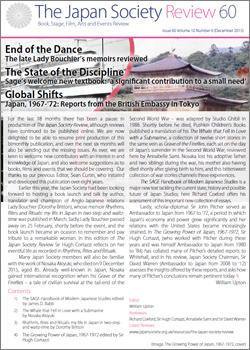Issue 60 (December 2015, Volume 10, Number 6)

For the last 18 months there has been a pause in production of The Japan Society Review, although reviews have continued to be published online. We are now delighted to be able to resume print production of this bimonthly publication, and over the next six months will also be sending out the missing issues. As ever, we are keen to welcome new contributors with an interest in and knowledge of Japan, and also welcome suggestions as to books, films and events that we should be covering. Our thanks to our previous Editor, Sean Curtin, who initiated and developed this publication over eight years.
Earlier this year, the Japan Society had been looking forward to hosting a book launch and talk by author, translator and champion of Anglo-Japanese relations Lady Bouchier (Dorothy Britton), whose memoir Rhythms, Rites and Rituals: my life in Japan in two-step and waltz- time was published in March. Sadly Lady Bouchier passed away on 25 February, shortly before the event, and the book launch became an ocasion to remember and pay tribute to a remarkable woman. In this edition of The Japan Society Review Sir Hugh Cortazzi reflects on her eventful life as recorded in Rhythms, Rites and Rituals.
Many Japan Society members will also be familiar with the work of Nosaka Akiyuki, who died on 9 December 2015, aged 85. Already well-known in Japan, Nosaka gained international recognition when his Grave of the Fireflies – a tale of civilian survival at the tail-end of the Second World War – was adapted by Studio Ghibli in 1988. Shortly before he died, Pushkin Children’s Books published a translation of his The Whale that Fell in Love with a Submarine, a collection of twelve short stories in the same vein as Grave of the Fireflies, each set on the day of Japan’s surrender in the Second World War, reviewed here by Annabelle Sami. Nosaka lost his adoptive father and two siblings during the war, his mother also having died shortly after giving birth to him, and this bittersweet collection of war stories channels these experiences.
The SAGE Handbook of Modern Japanese Studies is a major new text tackling the current state, history and possible future of Japan Studies; here Richard Coxford offers his assessment of this important new collection of essays.
Lastly, scholar-diplomat Sir John Pilcher served as Ambassador to Japan from 1967 to ‘72, a period in which Japan’s economy and power grew significantly and her relations with the United States became increasingly strained. In The Growing Power of Japan, 1967-1972, Sir Hugh Cortazzi, (who worked with Pilcher during these years and was himself Ambassador to Japan from 1980 to ’84) has collated many of Pilcher’s detailed reports to Whitehall, and in his review, Japan Society Chairman, Sir David Warren (Ambassador to Japan from 2008 to ‘12) assesses the insights offered by these reports, and asks how many of Pilcher’s conclusions remain pertinent today.
Contents
- The SAGE Handbook of Modern Japanese Studies edited by James D. Babb
- The Whale that Fell in Love with a Submarine by Nosaka Akiyuki
- Rhythms, Rites and Rituals: my life in Japan in two-step and waltz-time by Dorothy Britton
- The Growing Power of Japan, 1967-1972 edited by Sir Hugh Cortazzi
Contributors
Editor
William Upton
Reviewers
Richard Coxford, Sir Hugh Cortazzi, Annabelle Sami and Sir David Warren

